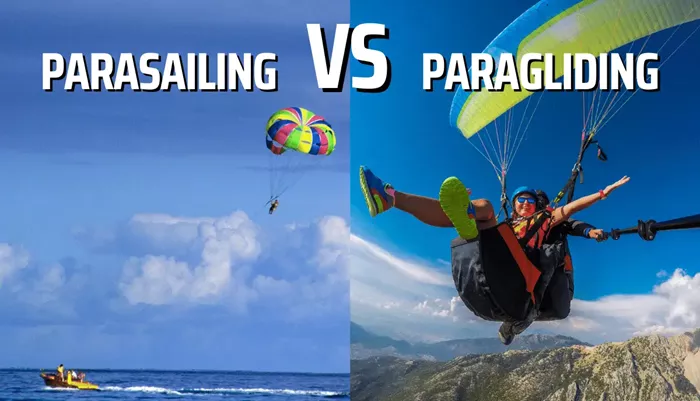When it comes to airborne adventures, few activities rival the thrill and exhilaration of parasailing and paragliding. While both sports involve soaring through the skies, they are distinct in terms of experience, technique, and equipment. This article will delve into the key differences between parasailing and paragliding, helping enthusiasts and beginners alike understand which sport might be the best fit for their next adventure.
What is Parasailing?
The Basics of Parasailing
Parasailing is a recreational activity where a person is towed behind a boat while attached to a specially designed parachute, known as a parasail. As the boat accelerates, the parasail lifts the participant into the air, offering a unique perspective of the surrounding landscape. The height and speed of the ride are controlled by the boat’s movement, making it a relatively passive and relaxed experience.
Equipment Used in Parasailing
The primary equipment required for parasailing includes:
Parasail Wing: A parachute-like canopy that catches the wind and lifts the rider.
Harness: Connects the participant to the parasail and provides support and comfort.
Tow Rope: A sturdy line that links the parasail to the boat.
Safety Gear: Life jackets and helmets are standard to ensure safety.
Locations and Accessibility
Parasailing is typically offered at coastal resorts, lakes, and other large bodies of water. It is a popular activity in tourist destinations due to its accessibility and the minimal physical effort required from participants.
What is Paragliding?
The Basics of Paragliding
Paragliding is an adventure sport where a person flies a lightweight, free-flying, foot-launched glider aircraft. Unlike parasailing, paragliding does not involve a boat. Instead, the pilot launches from a high point, such as a hill or mountain, and uses thermal currents to stay aloft. Paragliding offers a more immersive and active flying experience, requiring skill and knowledge to navigate the skies.
Equipment Used in Paragliding
The essential equipment for paragliding includes:
Paraglider Wing: An inflatable wing that resembles a parachute but is specifically designed for gliding.
Harness: A comfortable seat that attaches the pilot to the wing, equipped with safety features.
Helmet: Provides protection and is often equipped with communication devices.
Variometer: An instrument that measures altitude and the rate of ascent or descent.
Locations and Accessibility
Paragliding sites are usually found in mountainous regions or areas with suitable elevation for launching. It requires specific weather conditions and is often more physically demanding than parasailing. Paragliding schools and clubs offer training and tandem flights for beginners.
Key Differences Between Parasailing and Paragliding
Control and Skill Level
Parasailing: The rider has minimal control over the flight. The boat driver manages the speed, direction, and height, making it an easy and straightforward activity for beginners.
Paragliding: The pilot has complete control over the flight, using body movements and brake toggles to navigate. This requires training and practice, making it a more skill-intensive sport.
Experience and Sensation
Parasailing: Provides a relaxing, scenic experience with a focus on enjoying the view and the sensation of flight without the need for active participation.
Paragliding: Offers an exhilarating and dynamic flying experience. Pilots experience the thrill of navigating through the air, catching thermals, and potentially flying for hours.
Duration and Flight Dynamics
Parasailing: Flights are generally short, lasting between 10 to 15 minutes, depending on the operator and weather conditions.
Paragliding: Flights can last from a few minutes to several hours, depending on the pilot’s skill, weather conditions, and location.
Safety Considerations
Parasailing Safety
Parasailing is considered a safe activity when conducted by reputable operators who follow strict safety guidelines. Participants should always wear life jackets and helmets, and operators should regularly inspect equipment and monitor weather conditions to ensure safe flights.
Paragliding Safety
Paragliding carries more inherent risks due to the need for skill and knowledge in handling the glider. Pilots should undergo thorough training and use well-maintained equipment. Weather conditions play a crucial role in paragliding safety, and pilots must be adept at reading and responding to changing conditions.
Training and Certification
Parasailing
No formal training or certification is required for parasailing. Most operators provide a brief safety briefing before the flight. However, it is essential to choose experienced operators who prioritize safety.
Paragliding
Paragliding requires formal training from certified instructors. Courses typically cover ground handling, launching, landing techniques, and emergency procedures. Pilots may also need to obtain certifications depending on the country’s regulations and the complexity of the flying sites.
Cost and Accessibility
Parasailing
Parasailing is generally more affordable and accessible than paragliding. Prices vary depending on the location and duration of the flight but typically range from $50 to $150 per session. It is widely available at popular tourist destinations.
Paragliding
Paragliding can be more expensive due to the need for specialized equipment and training. Initial courses and equipment purchases can range from $1,000 to $3,000. However, once trained, pilots can enjoy relatively low-cost flying, with many sites offering free access to suitable launch points.
see also: Paragliding Vs. Paramotoring: What Is Differences?
Environmental Impact
Parasailing
Parasailing’s environmental impact is relatively low, primarily involving the boat’s fuel consumption. However, responsible operators should adhere to guidelines to minimize disruption to marine life and coastal ecosystems.
Paragliding
Paragliding is an environmentally friendly sport, as it relies on natural wind currents and thermals for flight. Pilots are encouraged to respect nature, avoid disturbing wildlife, and practice Leave No Trace principles.
Conclusion
Both parasailing and paragliding offer unique ways to experience the joy of flight, each with its distinct characteristics and appeal. Parasailing is perfect for those seeking a relaxed, scenic ride with minimal effort and maximum enjoyment. In contrast, paragliding attracts adventure seekers who relish the challenge and thrill of navigating the skies using their skills and knowledge. Whichever you choose, both sports promise unforgettable memories and a breathtaking perspective of the world from above.
related topics:
- Winter Vs. Summer: Which Is The Best Season For Paragliding?
- How Do Most Paragliding Accidents Happen
- Paragliding Vs Skydiving: Which Is More Safer?

